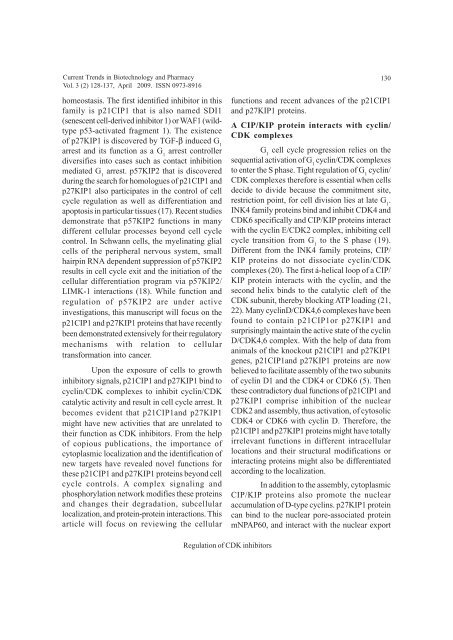April Journal-2009.p65 - Association of Biotechnology and Pharmacy
April Journal-2009.p65 - Association of Biotechnology and Pharmacy
April Journal-2009.p65 - Association of Biotechnology and Pharmacy
Create successful ePaper yourself
Turn your PDF publications into a flip-book with our unique Google optimized e-Paper software.
Current Trends in <strong>Biotechnology</strong> <strong>and</strong> <strong>Pharmacy</strong><br />
Vol. 3 (2) 128-137, <strong>April</strong> 2009. ISSN 0973-8916<br />
homeostasis. The first identified inhibitor in this<br />
family is p21CIP1 that is also named SDI1<br />
(senescent cell-derived inhibitor 1) or WAF1 (wildtype<br />
p53-activated fragment 1). The existence<br />
<strong>of</strong> p27KIP1 is discovered by TGF-β induced G 1<br />
arrest <strong>and</strong> its function as a G 1<br />
arrest controller<br />
diversifies into cases such as contact inhibition<br />
mediated G 1<br />
arrest. p57KIP2 that is discovered<br />
during the search for homologues <strong>of</strong> p21CIP1 <strong>and</strong><br />
p27KIP1 also participates in the control <strong>of</strong> cell<br />
cycle regulation as well as differentiation <strong>and</strong><br />
apoptosis in particular tissues (17). Recent studies<br />
demonstrate that p57KIP2 functions in many<br />
different cellular processes beyond cell cycle<br />
control. In Schwann cells, the myelinating glial<br />
cells <strong>of</strong> the peripheral nervous system, small<br />
hairpin RNA dependent suppression <strong>of</strong> p57KIP2<br />
results in cell cycle exit <strong>and</strong> the initiation <strong>of</strong> the<br />
cellular differentiation program via p57KIP2/<br />
LIMK-1 interactions (18). While function <strong>and</strong><br />
regulation <strong>of</strong> p57KIP2 are under active<br />
investigations, this manuscript will focus on the<br />
p21CIP1 <strong>and</strong> p27KIP1 proteins that have recently<br />
been demonstrated extensively for their regulatory<br />
mechanisms with relation to cellular<br />
transformation into cancer.<br />
Upon the exposure <strong>of</strong> cells to growth<br />
inhibitory signals, p21CIP1 <strong>and</strong> p27KIP1 bind to<br />
cyclin/CDK complexes to inhibit cyclin/CDK<br />
catalytic activity <strong>and</strong> result in cell cycle arrest. It<br />
becomes evident that p21CIP1<strong>and</strong> p27KIP1<br />
might have new activities that are unrelated to<br />
their function as CDK inhibitors. From the help<br />
<strong>of</strong> copious publications, the importance <strong>of</strong><br />
cytoplasmic localization <strong>and</strong> the identification <strong>of</strong><br />
new targets have revealed novel functions for<br />
these p21CIP1 <strong>and</strong> p27KIP1 proteins beyond cell<br />
cycle controls. A complex signaling <strong>and</strong><br />
phosphorylation network modifies these proteins<br />
<strong>and</strong> changes their degradation, subcellular<br />
localization, <strong>and</strong> protein-protein interactions. This<br />
article will focus on reviewing the cellular<br />
130<br />
functions <strong>and</strong> recent advances <strong>of</strong> the p21CIP1<br />
<strong>and</strong> p27KIP1 proteins.<br />
A CIP/KIP protein interacts with cyclin/<br />
CDK complexes<br />
G 1<br />
cell cycle progression relies on the<br />
sequential activation <strong>of</strong> G 1<br />
cyclin/CDK complexes<br />
to enter the S phase. Tight regulation <strong>of</strong> G 1<br />
cyclin/<br />
CDK complexes therefore is essential when cells<br />
decide to divide because the commitment site,<br />
restriction point, for cell division lies at late G 1<br />
.<br />
INK4 family proteins bind <strong>and</strong> inhibit CDK4 <strong>and</strong><br />
CDK6 specifically <strong>and</strong> CIP/KIP proteins interact<br />
with the cyclin E/CDK2 complex, inhibiting cell<br />
cycle transition from G 1<br />
to the S phase (19).<br />
Different from the INK4 family proteins, CIP/<br />
KIP proteins do not dissociate cyclin/CDK<br />
complexes (20). The first á-helical loop <strong>of</strong> a CIP/<br />
KIP protein interacts with the cyclin, <strong>and</strong> the<br />
second helix binds to the catalytic cleft <strong>of</strong> the<br />
CDK subunit, thereby blocking ATP loading (21,<br />
22). Many cyclinD/CDK4,6 complexes have been<br />
found to contain p21CIP1or p27KIP1 <strong>and</strong><br />
surprisingly maintain the active state <strong>of</strong> the cyclin<br />
D/CDK4,6 complex. With the help <strong>of</strong> data from<br />
animals <strong>of</strong> the knockout p21CIP1 <strong>and</strong> p27KIP1<br />
genes, p21CIP1<strong>and</strong> p27KIP1 proteins are now<br />
believed to facilitate assembly <strong>of</strong> the two subunits<br />
<strong>of</strong> cyclin D1 <strong>and</strong> the CDK4 or CDK6 (5). Then<br />
these contradictory dual functions <strong>of</strong> p21CIP1 <strong>and</strong><br />
p27KIP1 comprise inhibition <strong>of</strong> the nuclear<br />
CDK2 <strong>and</strong> assembly, thus activation, <strong>of</strong> cytosolic<br />
CDK4 or CDK6 with cyclin D. Therefore, the<br />
p21CIP1 <strong>and</strong> p27KIP1 proteins might have totally<br />
irrelevant functions in different intracellular<br />
locations <strong>and</strong> their structural modifications or<br />
interacting proteins might also be differentiated<br />
according to the localization.<br />
In addition to the assembly, cytoplasmic<br />
CIP/KIP proteins also promote the nuclear<br />
accumulation <strong>of</strong> D-type cyclins. p27KIP1 protein<br />
can bind to the nuclear pore-associated protein<br />
mNPAP60, <strong>and</strong> interact with the nuclear export<br />
Regulation <strong>of</strong> CDK inhibitors













